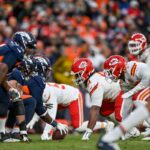Are the Broncos playing fast and loose with concussion protocol?
“The Broncos appear to be minimizing concerns regarding head injuries and hastening players’ return to play by seeing that they undergo as little testing and monitoring as they can possibly get away with.”
Read More …
“Oh, no. Not Duke”
When Duke Ihenacho exited last nights Broncos Patriots game after suffering a nasty helmet-to-helmet hit it looked as though his night was through. He laid on the field for a moment looking unconscious and was then helped back to the locker room.
But Duke wasn’t done. He trotted back onto the field and finished the game after presumably passing whatever tests were performed in the belly of the stadium.
His return to play came one week after receiver Wes Welker underwent the same process. Only in Welker’s case he was discovered not to be healthy after being sent back onto the field of play. After only a handful of plays Welker was once again removed from the game for displaying symptoms of head trauma. Denver Post columnist Benjamin Hochman chronicled the haste with which the Broncos medical staff brought Welker back in an article dated November 19.
The Broncos announced early last week that Welker would be good to go for the Patriots game. To many observers the proclamation seemed premature. Then word came that he would still need to be cleared by doctors – but by then it was clear that Welker would be facing his former team no matter what.
It seems like the Broncos are laughing in the face of the NFL’s concussion protocols.
With the settlement of the huge concussion lawsuit earlier this year the league promised to take head trauma more seriously without openly admitting that more could have been done in the past to mitigate the long-term harm injuries can bring. Specifically, the cognitive disease known as CTE – which hundreds of former NFL players are believed to suffer from – has been tied to repeated concussions. The medical community has learned that damage from head trauma is exacerbated by repetition and that players are at far less risk of long-term damage if their brains are allowed to properly rest after an injury occurs.
But the Broncos are still hurrying concussed players back. The team claims that both Welker and Ihenacho were cleared to play in the proper way but it doesn’t seem like it. Not at all.
According to the protocols put in place by the ‘NFL head, neck and spine committee” (which can be found online), a player believed to have suffered a concussion must 1) undergo “NFL sideline concussion assessment” and 2) “be observed in the locker room by qualified medical personnel”. These tests are the minimum allowed. Best practices, however, are said to include “serial concussion evaluations every twenty minutes for sixty minutes” because “a concussive injury may evolve and may not be apparent for several minutes or hours”. The document also states: “It is important to recognize that players may be able to equal or exceed their performance under the sideline concussion assessment ti their baseline level yet still have a concussion”.
The Broncos appear to be minimizing concerns regarding head injuries and hastening players’ return to play by seeing that they undergo as little testing and monitoring as they can possibly get away with. Watching the way the injuries to Welker and Ihenacho were handled by the Broncos it’s tough to believe that they care at all about the protocols beyond doing whatever is necessary not to draw scrutiny from the league.
Football players are football players and we all realize that they play a tough game. The players know it, too. But when it comes to the health of their minds every precaution must be taken. These players are young. They will be young when they retire. They have their entire lives ahead of them and it’s beyond unfair to make wins a higher priority than their long term health.
As disappointing as it was that the Broncos lost last night it would be far worse to know that the Broncos are playing fast and loose with player safety.





